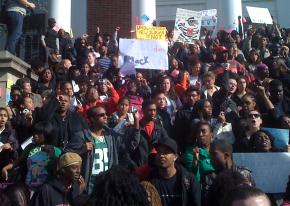Determined to defend diversity
and describe the struggle against cuts in multicultural programs at the University of Maryland.
SOME 600 angry students marched across the University of Maryland campus in College Park November 5 to demand the reinstatement of Assistant Provost of Equity and Diversity Dr. Cordell Black, and to protest cuts to important multicultural programs.
Highly respected and beloved both on and off campus for his long-standing commitment to minority representation and equal opportunity, Black oversaw the operation of the Nyumburu Cultural Center, the Office of Multi-Ethnic Student Education, and the Office of Lesbian, Gay, Bisexual and Transgender (LGBT) Equity.
Under the guise of budget problems, the administration plans to eliminate Black's position next year, despite significant concern in the university community that this move would severely hinder efforts to increase diversity and support minority students.
Some protesters carried signs that read "Whose School? Our School" and "Education, Not Industry." With fists in the air and chants of "Bring back Black!" and "This is what diversity looks like!" throngs of students marched to the main administration building, where they filled a plaza and street, stormed the concrete steps, and taped hundreds of multicolored handwritten notes on the building expressing their outrage.

"I'm here to send a message to the university that when they cut out a significant member of our community, it affects us all," said Joe, a student organizer at the rally.
Many students were infuriated that the administration's decision to cut Black's job was made behind closed doors only a week after the school held a town hall meeting on building diversity, where administrators unveiled a new "diversity plan" and restated their commitment to increase the multicultural dimension of the school.
At the meeting, officials were forced to address the alarming decline in minority enrollment. In this past year alone, while the overall admission of the school has multiplied, African American enrollment has declined by 28 percent. "What do you think that figure will be after we have more tuition hikes?" asked Malcolm Harris, a member of Students for a Democratic Society.
STUDENTS ARE aware that Dr. Black's removal is symptomatic of a larger attack on their community.
Along with Black's removal, the university is discussing a plan to merge the African American, Latin American, LGBT and Women's Studies departments into one, claiming that school funds are insufficient to sustain their individual autonomy. In addition, the university is packing more students into fewer classes by eliminating certain so-called "extraneous" classes and raising the seat caps on the classes that remain.
Yet just this semester, the school built a new Journalism School building, installed a giant fountain in front of the Tawes Building and spent $250,000 on a rebranding slogan for the school: "Unstoppable starts here."
What's more, official signs around campus tout a recent 30 percent increase in research funding. If the school can't maintain the programs it already has, why is it funding expansion? Students are demanding to know why the first budget cuts are those that directly affect minorities and why the programs that make more money, such as Engineering, Computer Science and Business, aren't getting cut at all.
Dozens of student organizations sponsored the march, calling not just for Black's reinstatement but also for public disclosure of all university budget documents and for a moratorium on all layoffs, program cuts or department restructuring until students, faculty and staff are given a seat at the table.
Liz Cerezo, a member of Pride Alliance who initiated the call for the march, referred to the new $250,000 slogan when she said, "Unstoppable may start here, but injustice will end here!"
"I'm tired of always being excluded," said Lidia Rosas of the Latino Student Union. "We need transparency in this administration. We demand to be included."
The march was called the night before, when hundreds of students and faculty gathered for a forum to discuss Black's dismissal and what to do about it. Many students spoke about the history of activism at the University of Maryland, referring to the movement to divest university funds from South Africa in the 1970s.
"It's not just happening to Dr. Black," said one student at the rally. "What about all the minority faculty and staff who are being laid off?" Another student added, "What will happen if we don't fight? What will happen to other faculty, or to next year's freshman class?"
Leaders of various student organizations have had four organizing meetings since the march to lay the foundations of a new student coalition called Students Taking Action to Reclaim our Education, or STARE, and to plan the next steps for the campaign. At an organizing meeting November 6, students challenged themselves to think about what it would take to build what they called a "long-term, sustainable movement" with the students having the ability to vote on every decision-making body on campus.
As Sana Javed of Students for Justice in Palestine said, "We will make them hear us! We can demonstrate, we can disrupt their football games, we can block off Route 1. We will keep escalating until they give us a seat at the table. We will not take no for an answer."


